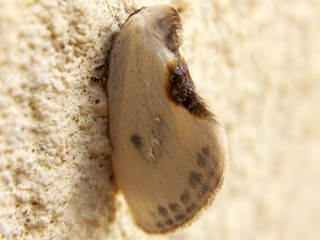Cilix was, according to Greek mythology, a Phoenician prince as the son of King Agenor and Telephassa or Argiope.

The Drepanidae are a family of moths with about 660 species described worldwide. They are generally divided in three subfamilies, which share the same type of hearing organ. Thyatirinae, previously often placed in their own family, bear a superficial resemblance to Noctuidae. Many species in the drepanid family have a distinctively hook-shaped apex to the fore wing, leading to their common name of hook-tips.

Drepaninae are by far the largest subfamily of the Drepanidae moths. While it is usually split into two tribes, Drepanini and Oretini, its internal systematics and phylogeny are not well resolved.

The Thyatirinae, or false owlet moths, are a subfamily of the moth family Drepanidae with about 200 species described. Until recently, most classifications treated this group as a separate family called Thyatiridae.

Cilix glaucata, the Chinese character, is a moth of the family Drepanidae. It was first described by the Italian physician and naturalist, Giovanni Antonio Scopoli in his 1763 Entomologia Carniolica. It is found in Europe, Asia Minor and North Africa.

Ochropacha is a monotypic moth genus in the family Drepanidae. The genus was first described by Hans Daniel Johan Wallengren in 1871. Its single species, Ochropacha duplaris, the common lutestring, was first described by Carl Linnaeus in 1761. It is found in China (Jilin), Russia, Japan, the Korean Peninsula and from Central Asia to Europe.

Polyploca ridens, the frosted green, is a moth of the family Drepanidae. It is found in southern and central Europe, England, Denmark, southern Sweden and in the east up to Russia.
Depalpata is a genus of moths of the family Noctuidae.

Cilix is a genus of moths belonging to the subfamily Drepaninae. The genus was erected by Leach in 1815.

Cilix asiatica is a species of moth in the family Drepanidae first described by Otto Bang-Haas in 1907. It is found in Ukraine, Romania, Bulgaria, North Macedonia, Greece, the eastern parts of Turkey, Israel and Lebanon. The habitat consists of xerothermic woodland.

Cilix hispanica is a moth in the family Drepanidae. It is found in Portugal, Spain, southern France, Italy and North Africa.
Cilix algirica is a moth in the family Drepanidae described by Patrice J.A. Leraut in 2006. It is found in Morocco, Algeria and possibly Portugal.
Cilix danieli is a moth in the family Drepanidae first described by Watson in 1968. It is found in Shanxi, China.
Cilix filipjevi is a moth in the family Drepanidae first described by Nikolai Ivanovich Kardakoff in 1928. It is found in the Russian Far East (Ussuri), Korea, north-eastern China and Japan.
Cilix patula is a moth in the family Drepanidae first described by Watson in 1968. It is found in Yunnan, China.
Cilix tatsienluica is a moth in the family Drepanidae first described by Oberthür in 1916. It is found in China.
Cilix argenta is a moth in the family Drepanidae. It is found in China.
Cilix is a small crater on Europa that serves as the reference point for the moon's system of longitude. The longitude of Cilix's center is defined as being 182° W, thus establishing the moon's prime meridian. It is named after Cilix, the brother of Europa








